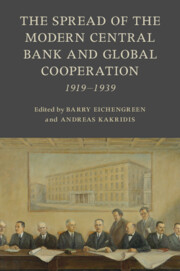Book contents
- The Spread of the Modern Central Bank and Global Cooperation
- Studies in Macroeconomic History
- The Spread of the Modern Central Bank and Global Cooperation
- Copyright page
- Contents
- Figures
- Tables
- Editors and Contributors
- Preface
- Part I General
- 1 Interwar Central Banks
- 2 The Ideology of Central Banking in the Interwar Years and Beyond
- 3 Habit Not Heredity
- 4 Institutionalizing Central Bank Cooperation
- Part II Specific
- Index
- References
4 - Institutionalizing Central Bank Cooperation
The Norman–Schacht Vision and Early Experience of the Bank for International Settlements, 1929–1933
from Part I - General
Published online by Cambridge University Press: 02 November 2023
- The Spread of the Modern Central Bank and Global Cooperation
- Studies in Macroeconomic History
- The Spread of the Modern Central Bank and Global Cooperation
- Copyright page
- Contents
- Figures
- Tables
- Editors and Contributors
- Preface
- Part I General
- 1 Interwar Central Banks
- 2 The Ideology of Central Banking in the Interwar Years and Beyond
- 3 Habit Not Heredity
- 4 Institutionalizing Central Bank Cooperation
- Part II Specific
- Index
- References
Summary
The creation of the Bank for International Settlements (BIS) in 1929 to deal with the settlement of First World War reparations payments was seen by central banks as an opportunity to put international cooperation on an institutional footing. Their initial vision of what the BIS might achieve in support of the gold exchange standard was ambitious. In the view of Montagu Norman and Hjalmar Schacht, the BIS needed to become a forum not merely for information exchange and for refining the techniques of managing the gold exchange standard, but a truly cooperative organisation capable of providing support to central banks in emergencies and for developing new financial arrangements. This chapter investigates the scope of the Norman-Schacht vision, as well as attempts to put this vision into practice (e.g. through the BIS study committee on medium-term credits, or through the BIS-coordinated interventions in the Austrian banking and financial crisis of May-June 1931). Based on research in the historical archives of the BIS, this chapter assesses whether the Norman-Schacht vision for the BIS failed because of differences in policies and goals among the central banks, or rather because of the disruptive effects of the Great Depression.
Keywords
Information
- Type
- Chapter
- Information
- The Spread of the Modern Central Bank and Global Cooperation1919–1939, pp. 80 - 102Publisher: Cambridge University PressPrint publication year: 2023
References
Primary Sources
Secondary Sources
Accessibility standard: Unknown
Why this information is here
This section outlines the accessibility features of this content - including support for screen readers, full keyboard navigation and high-contrast display options. This may not be relevant for you.Accessibility Information
- 3
- Cited by
